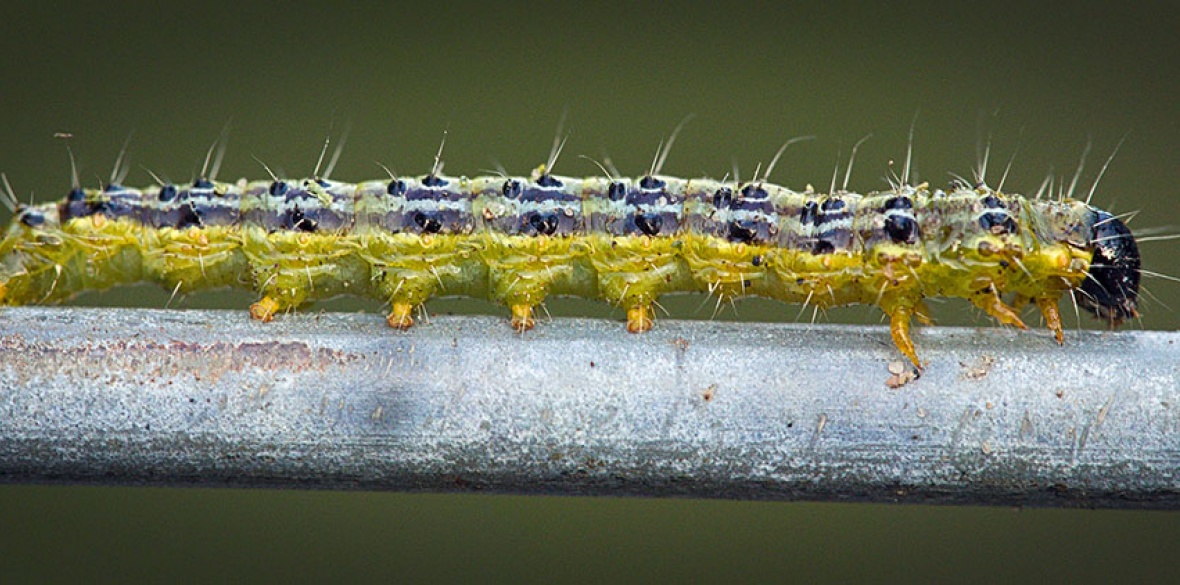This is the last article you can read this month
You can read more article this month
You can read more articles this month
Sorry your limit is up for this month
Reset on:
Please help support the Morning Star by subscribing here
A KIND friend gave me a nice present this Christmas. It was a plant for my garden — a beautifully clipped globe shaped topiary-box tree about a foot high and a foot in diameter.
I thanked her profusely but was a tiny bit worried as I had heard about these imported box plants. They are available at remarkably low prices for such labour intensive products being grown in Asia. Sadly some of them have brought a relatively new insect pest to Britain.
This is the box tree caterpillar that weaves a white web over the plant — and inside that web eats the leaves and often kills the plant. The caterpillar was first seen in Britain in 2008 and was being spotted in English gardens by 2011.
Butterfly Conservation tell me the caterpillars have been brought over by the horticultural trade and climate change. I took their advice and searched my plant for the caterpillars, which are yellow with black and white stripes on their bodies and black heads. They can grow to one and a half inches long. I’ll search again every week or so for a few months in case there are eggs or pupae hiding and still to hatch.
This pest is likely to become a serious problem and may begin to destroy all our native box trees including those amazing shaped topiary in formal gardens and wild box woodlands like Box Hill. Box is used by craftspeople to make fine furniture, musical instruments and — you guessed — boxes.
Box is just one of our native trees threatened by a whole galaxy of imported pests that are arriving in Britain as an unwanted side-effect of easier transport and international trade in exotic foreign-cultivated garden plants.
Climate change too makes our seasons more suitable for some of these pests used to warmer and wetter parts of the world.
Some pests arrive on the plants themselves and some in wooden packaging that ironically is becoming more popular as we try to move away from plastic. Cheaper and more popular air freight also plays a part in this green invasion.
Perhaps our proudest tree, the mighty oak, is certainly under pressure like never before. Oaks are declining at an unprecedented rate due to imported pests and a number of diseases as well as drought, flooding and pollution.
The oak processionary moth not only strips oak trees of their leaves, leaving them vulnerable, but also poses a health risk to humans, causing rashes and breathing difficulties.
An insect pest that has not yet arrived in our woods is the oak lace bug that also attacks oaks, reducing growth and weakening trees. With a number of other diseases already affecting oaks, the arrival of the oak lace bug might be the last nail in an oaken coffin.
Our native Scots pine, our only native evergreen, can suffer from a needle blight fungus that can kill these magnificent trees that grow to more than 150 feet in our rare, ecologically invaluable Caledonian pine forests.
Proud avenues of horse chestnut are a delight of our countryside and not just for their conkers. The larvae of the horse chestnut leaf miner bores within horse-chestnut leaves, eventually causing them to drop, leaving the whole tree vulnerable
The great spruce bark beetle damages spruce trees by tunnelling into the bark. This pest was accidentally introduced into Britain in 1982 and has become established in Western England, Wales and Southern Scotland.
Many of these pests and diseases have no popular names and go by long unpronounceable Latin monikers. Some do have popular names and among these none beats the elbow-patch crust.
This is a fungal disease of London plane trees. These London planes are a complicated hybrid of various plane trees. The fungus gets its common English name from the appearance of the fungus patches, or cankers, on bends in the branches, which look like elbow patches
Outside of the capital other plane species too are suffering from a serious wilt. Plane wilt is usually fatal within two to five years.
Gin fans will worry about phytophthora austrocedri, a pathogen that infects and kills native juniper trees. Junipers are the berries that give gin its distinct flavour and its name — from Jenever, Dutch for gin. It is one of our rarest native trees and an attack from this fungal-like species is a devastating blow to some of Britain’s populations.
Phytophthora ramorum is a fungal-like organism that causes the death of a wide range of trees and shrubs. The greatest impact so far has been on larch plantations, leading to thousands of hectares of felling around Britain.
Here are some more pests, not yet arrived on our soil yet, but it can only be a matter of time before they arrive to wreak havoc on the British countryside. I remember what a huge impact what we called Dutch elm disease had on our native hedgerows and field boundaries.
Sweet chestnut blight fungus infects trees through fissures or wounds, and it has the potential to have a significant impact on our historic sweet chestnut woods.
Another chestnut threat, this one newly arrived, is the oriental chestnut gall wasp. It is the only organism to produce galls – tumour-like growths – on sweet chestnuts. If numbers grow, it could have a serious impact on our historic and handsome trees.
I visit a fine local sweet-chestnut tree every autumn to harvest the nuts that I will cook with my sprouts on Christmas day and would hate to be reduced to buying imported chestnuts, or worse even tinned chestnuts from the local supermarket.
The Asian longhorn beetle kills many species of broadleaf trees. It’s not in Britain yet, but there’s a high risk of it being imported on wood packaging.
The Bronze birch borer, native to the US, is another pest which could have a huge impact, this time on our native birches.
The emerald ash borer has killed billions of ash trees in the US. If it gets to Britain it will do the same to our already vulnerable ash populations.
A European ringspot-associated virus attacks the leaves of rowan trees. It would be sad if our beautiful mountain ash trees were threatened.
Feeding on the needles of pine trees in Asia, Africa and southern Europe, the pine processionary moth is heading north towards Britain. It can rapidly strip pines of their needles.
The red-necked longhorn beetle is native to eastern Asia and is a serious threat to trees like cherries and plums. Its larvae tunnel under bark and in the wood causing low fruiting and death.
Organisations like the Royal Horticultural Society and the Woodland Trust are fighting back and working hard to protect our native forests and woodlands from this regiment of pests and diseases.
Visit their websites to help with surveys to spot the arrival and spread of these evil threats to our green and pleasant woodlands.
Those of us lucky enough to have gardens must also do all we can to keep an eye out for these unwelcome invaders among the plants we introduce to our plots.










